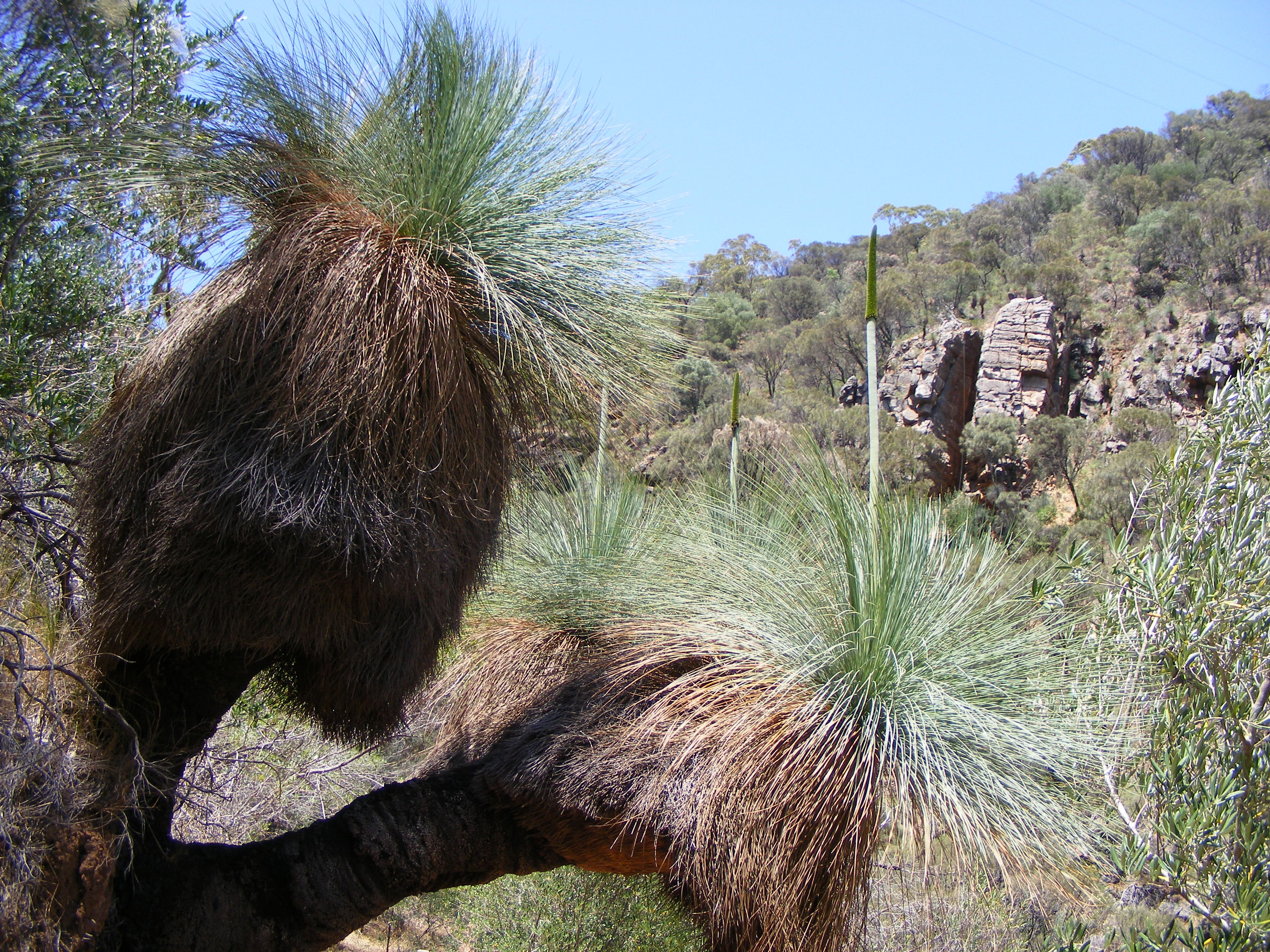- Xanthorrhoea
Taxobox
name = "Xanthorrhoea"

image_caption = "Xanthorrhoea quadrangulata"
regnum =Plantae
divisio = Magnoliophyta
classis =Liliopsida
ordo =Asparagales
familia =Xanthorrhoeaceae
familia_authority = Dumort.
genus = "Xanthorrhoea"
genus_authority = Sol. ex Sm.
subdivision_ranks = Species
subdivision =see text"Xanthorrhoea" is a
genus offlowering plant s native toAustralia and a member of family Xanthorrhoeaceae. The Xanthorrhoeaceae aremonocot s, part of orderAsparagales . There are 28species and five subspecies of "Xanthorrhoea". [Bedford, D.J. (1986) "Xanthorrhoea", in: A.S. George, (Ed) "Flora of Australia" 46:148-169] All are perennials and have a secondary thickening meristem in the stem. Many, but not all, species develop an above ground stem. This is rough-surfaced, built from accumulated leaf-bases around the secondarily thickened trunk. The trunk is sometimes unbranched, some species will branch if the growing point is damaged and others naturally grow numerous branches. Flowers are borne on a long spike above a bare section called a scape, the total length can be up to fourmetre s long in some species. Flowering occurs in a distinct flowering period, which varies for each species. Flowering can be stimulated bybushfire , in which case it occurs in the next flowering period after the fire.It is commonly believed that the "Xanthorrhoea" grow at a rate of about an
inch (2½ cm) per century. "Xanthorrhoea" do grow very slowly, but this is a gross underestimate: after an initial establishment phase the average rate of growth varies for each species but can be as high as about 2½ cm per year. Thus a five-metre tall member of one of the fastest growing "Xanthorrhoea" would be about 200 years old. A slow one may have a lifespan of 600 years."Xanthorrhoea" may be cultivated, as seed is easily collected and germinated. Whilst they do grow slowly, quite attractive plants with short trunks (10 cm) and leaf crowns up to 1.5 m (to the top of the leaves) can be achieved in 10 years. The slow growth rate means that it can take 30 years to achieve a specimen with a significant trunk. Most "Xanthorrhoea" sold in nurseries are established plants taken from bushland. Nurseries charge high prices for the plants. However, there is a very low survival rate for nursery purchased plants, which may take 3-4 years to die. The most successful examples of transplanting have been where a substantial amount of soil (> 1 cubic metre) has been taken with the plants.
The best known common name for the "Xanthorrhoea" is blackboy. This name refers to the purported similarity in appearance of the trunked species to an Aboriginal boy holding an upright spear. In 2007, some people consider this name to be offensive, or at least belonging to the past, preferring instead grasstree, or in the South West the
Noongar name balga for "X. preissei". InSouth Australia it is commonly known asyakka , also spelled yacca and yacka. This probably is from a South Australian Aboriginal language, [Peters, Pam, "The Cambridge Australian English Style Guide", Cambridge University Press, 1996, p823] mostly likelyKaurna .Traditional Aboriginal uses
Xanthorrhoea is important to the Aboriginal people who live where it grows. The flowering spike makes the perfect fishing spear. It is also soaked in water and the nectar from the flowers gives a sweet tasting drink. In the bush the flowers are used as a compass. This is because flowers on the warmer, sunnier side of the spike (usually the north facing side) often open before the flowers on the cooler side facing away from the sun. [ [http://www.abc.net.au/gardening/stories/s1145455.htm Gardening Australia - Fact Sheet: Xanthorrea ] ]
The resin from Xanthorrhoea plants is used in
spear -making [ [http://www.abc.net.au/quantum/s188496.htm Quantum - Ancient Resin ] ] and is an invaluable adhesive for Aboriginal people, often used to patch up leaky coolamons (water-containers) and even yidaki (didgeridoos).imilar plants
*
Kingia and "Dasypogon" are unrelated Australian plants with a similar growth habit to "Xanthorrhoea". Both genera have at times been confused with xanthorrhoeas and mis-named as grasstrees. Some plant classification systems such as Cronquist [ Cronquist, A.J. "An Integrated System of Classification of Flowering Plants," Columbia University Press, New York 1981] have included a wide range of other genera in the same family as "Xanthorrhoea". However, later anatomical and phylogenetic research has supported the view of Dahlgren [ Dahlgren, R.M.T., (1980), "A revised system of classification of the angiosperms" "Bot.J. Linn. Soc." 80:91-124] who regarded "Xanthorrhoea" as the sole member of the family Xanthorrhoeaceae.pecies
*"
Xanthorrhoea acanthostachya "
*"Xanthorrhoea acaulis "
*"Xanthorrhoea arborea "
*"Xanthorrhoea arenaria "
*"Xanthorrhoea australis "
*"Xanthorrhoea bracteata "
*"Xanthorrhoea brevistyla "
*"Xanthorrhoea brunonis "
*"Xanthorrhoea caespitosa "
*"Xanthorrhoea concava "
*"Xanthorrhoea drummondii "
*"Xanthorrhoea fulva "
*"Xanthorrhoea glauca "
*"Xanthorrhoea gracilis "
*"Xanthorrhoea johnsonii "
*"Xanthorrhoea latifolia "
*"Xanthorrhoea macronema "
*"Xanthorrhoea malacophylla "
*"Xanthorrhoea media "
*"Xanthorrhoea minor "
*"Xanthorrhoea nana "
*"Xanthorrhoea platyphylla "
*"Xanthorrhoea preissii "
*"Xanthorrhoea pumilio "
*"Xanthorrhoea quadrangulata "
*"Xanthorrhoea reflexa "
*"Xanthorrhoea resinifera " (also called Xanthorrhoea hastilis)
*"Xanthorrhoea semiplana "
*"Xanthorrhoea thorntonii "Image gallery
ee also
*
Kingia References
External links
* [http://www.pfaf.org/database/plants.php?Xanthorrhoea+australis Xanthorrhoea australis - R.Br.] Plants For A Future
* [http://www.pawlan.com/Monica/xanthor/ XANTHORRHOEA INFORMATION PAGE] Monica Pawlan
*FloraBase | name = Xanthorrhoea | id = 21189
* [http://www.anbg.gov.au/aborig.s.e.aust/xanthorrhoea-species.html Xanthorrhoea] , [http://www.anbg.gov.au/cgi-bin/apni "Australian Plant Name Index (APNI)"]
Wikimedia Foundation. 2010.
